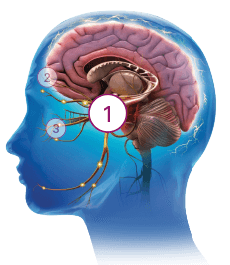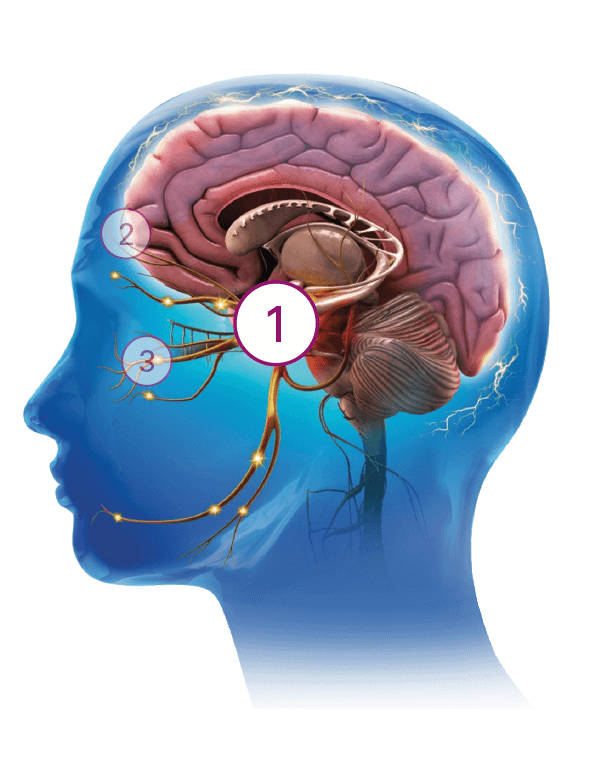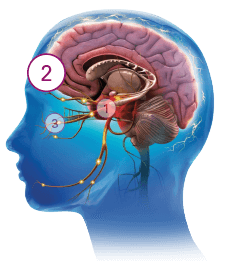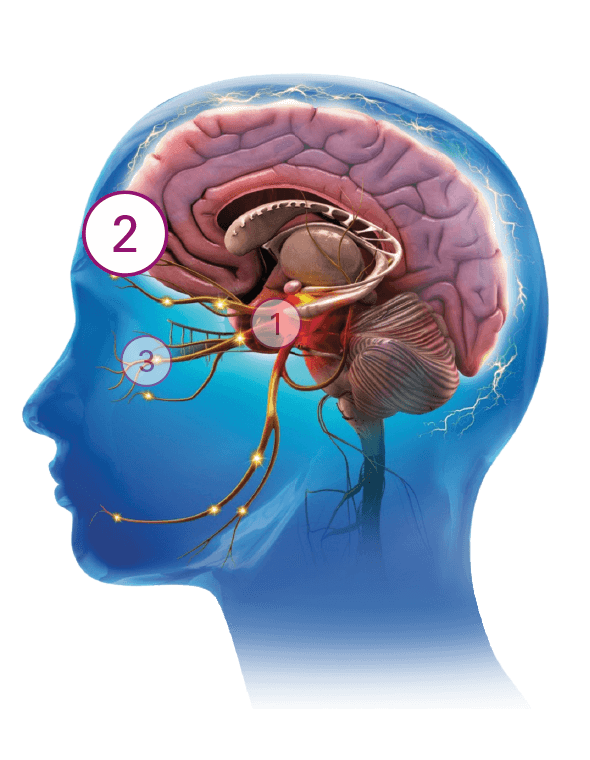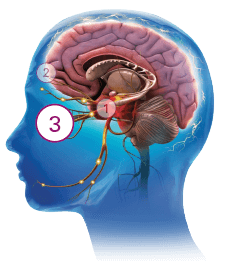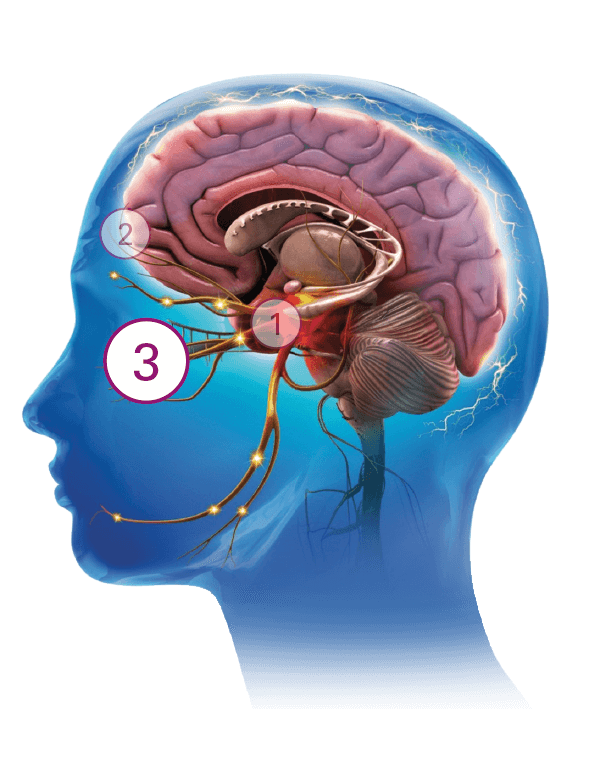INDICATIONS AND USAGE
CAMBIA® (diclofenac potassium) for oral solution is
indicated for the acute treatment of migraine attacks with or
without aura in adults (18 years of age or older).
Limitations of Use:
-
CAMBIA is not indicated for the prophylactic therapy of
migraine.
-
The safety and effectiveness of CAMBIA have not been
established for cluster headache.
CAMBIA® (diclofenac potassium) for oral solution is
indicated for the acute treatment of migraine attacks with or
without aura in adults (18 years of age or older).
Limitations of Use:
-
CAMBIA is not indicated for the prophylactic therapy of
migraine.
-
The safety and effectiveness of CAMBIA have not been
established for cluster headache.
IMPORTANT SAFETY INFORMATION
WARNING: RISK OF SERIOUS CARDIOVASCULAR AND GASTROINTESTINAL
EVENTS
Cardiovascular Thrombotic Events
-
Non-steroidal anti-inflammatory drugs (NSAIDs) cause an
increased risk of serious cardiovascular thrombotic events,
including myocardial infarction, and stroke, which can be
fatal. This risk may occur early in treatment and may increase
with duration of use.
-
CAMBIA is contraindicated in the setting of coronary artery
bypass graft (CABG) surgery.
Gastrointestinal Bleeding, Ulceration, and Perforation
-
NSAIDs cause an increased risk of serious gastrointestinal
(GI) adverse events including bleeding, ulceration, and
perforation of the stomach or intestines, which can be fatal.
These events can occur at any time during use and without
warning symptoms. Elderly patients and patients with a prior
history of peptic ulcer disease and/or GI bleeding are at
greater risk for serious GI events.
DOSAGE AND ADMINISTRATION
Use the lowest effective dosage for the shortest duration
consistent with individual patient treatment goals. The safety and
effectiveness of a second dose have not been established.
Non-Interchangeability with Other Formulations of
Diclofenac
Different formulations of oral diclofenac are not bioequivalent
even if the milligram strength is the same. Therefore, it is not
possible to convert dosing from any other formulation of
diclofenac to CAMBIA.
CONTRAINDICATIONS
CAMBIA is contraindicated in the following patients:
-
Known hypersensitivity (e.g., anaphylactic reactions and serious
skin reactions) to diclofenac or any components of the drug
product
-
History of asthma, urticaria, or other allergic-type reactions
after taking aspirin or other NSAIDs. Severe, sometimes fatal,
anaphylactic reactions to NSAIDs have been reported in such
patients.
-
In the setting of coronary artery bypass graft (CABG) surgery.
WARNINGS AND PRECAUTIONS
Cardiovascular Thrombotic Events
Clinical trials of several COX-2 selective and nonselective NSAIDs
of up to three years duration have shown an increased risk of
serious cardiovascular (CV) thrombotic events, including
myocardial infarction (MI) and stroke, which can be fatal.
To minimize the potential risk for an adverse CV event in
NSAID-treated patients, use the lowest effective dose for the
shortest duration possible. Physicians and patients should remain
alert for the development of such events, throughout the entire
treatment course, even in the absence of previous CV symptoms.
Patients should be informed about the symptoms of serious CV
events and the steps to take if they occur.
Post-MI Patients
Avoid the use of CAMBIA in patients with a recent MI unless the
benefits are expected to outweigh the risk of recurrent CV
thrombotic events. If CAMBIA is used in patients with a recent MI,
monitor patients for signs of cardiac ischemia.
Gastrointestinal Bleeding, Ulceration, and Perforation
NSAIDs, including diclofenac, cause serious gastrointestinal (GI)
adverse events including inflammation, bleeding, ulceration, and
perforation of the esophagus, stomach, small intestine, or large
intestine, which can be fatal. These serious adverse events can
occur at any time, with or without warning symptoms, in patients
treated with NSAIDs. Only one in five patients who develop a
serious upper GI adverse event on NSAID therapy is symptomatic.
See full Prescribing Information for more information.
Hepatotoxicity
Inform patients of the warning signs and symptoms of
hepatotoxicity (e.g., nausea, fatigue, lethargy, diarrhea,
pruritus, jaundice, right upper quadrant tenderness, and
"flu-like" symptoms). If clinical signs and symptoms consistent
with liver disease develop, or if systemic manifestations occur
(e.g., eosinophilia, rash, etc.), discontinue CAMBIA immediately,
and perform a clinical evaluation of the patient.
To minimize the potential risk for an adverse liver-related event
in patients treated with CAMBIA, use the lowest effective dose for
the shortest duration possible.
Hypertension
NSAIDs, including CAMBIA, can lead to new onset of hypertension or
worsening of pre-existing hypertension, either of which may
contribute to the increased incidence of CV events. Use NSAIDs,
including CAMBIA, with caution in patients with hypertension.
Monitor blood pressure closely during the initiation of NSAID
treatment and throughout the course of therapy.
Patients taking angiotensin converting enzyme (ACE) inhibitors,
thiazides, or loop diuretics may have impaired response to these
therapies when taking NSAIDs.
Heart Failure and Edema
A meta-analysis of randomized controlled trials demonstrated an
approximately two-fold increase in hospitalizations for heart
failure in COX-2 selective-treated patients and nonselective
NSAID-treated patients compared to placebo-treated patients. In a
National Registry study of patients with heart failure, NSAID use
increased the risk of MI, hospitalization for heart failure, and
death.
Additionally, fluid retention and edema have been observed in some
patients treated with NSAIDs. Use of diclofenac may blunt the CV
effects of several therapeutic agents used to treat these medical
conditions (e.g., diuretics, ACE inhibitors, or angiotensin
receptor blockers [ARBs]).
Avoid the use of CAMBIA in patients with severe heart failure
unless the benefits are expected to outweigh the risk of worsening
heart failure. If CAMBIA is used in patients with severe heart
failure, monitor patients for signs of worsening heart failure.
Renal Toxicity and Hyperkalemia
Renal Toxicity
Monitor renal function in patients with renal or hepatic
impairment, heart failure, dehydration, or hypovolemia. Avoid use
of CAMBIA in patients with advanced renal disease unless benefits
are expected to outweigh risk of worsening renal function.
Anaphylactic Reactions
Diclofenac has been associated with anaphylactic reactions in
patients with and without known hypersensitivity to diclofenac and
in patients with aspirin-sensitive asthma. Seek emergency help if
an anaphylactic reaction occurs.
Exacerbation of Asthma Related to Aspirin Sensitivity
CAMBIA is contraindicated in patients with aspirin-sensitive
asthma. Monitor patients with preexisting asthma (without aspirin
sensitivity).
Serious Skin Reactions
NSAIDs, including diclofenac, can cause serious skin adverse
events such as exfoliative dermatitis, Stevens-Johnson Syndrome
(SJS), and toxic epidermal necrolysis (TEN), which can be fatal.
These serious events can occur without warning.
CAMBIA should be discontinued at the first appearance of skin rash
or any other sign of hypersensitivity. CAMBIA is contraindicated
in patients with previous serious skin reactions to NSAIDs.
Medication Overuse Headache
Overuse of acute migraine drugs (e.g., ergotamine, triptans,
opioids, nonsteroidal anti-inflammatory drugs or combination of
these drugs for 10 or more days per month) may lead to
exacerbation of headache (medication overuse headache). Medication
overuse headache may present as migraine-like daily headaches or
as a marked increase in frequency of migraine attacks.
Detoxification of patients, including withdrawal of the overused
drugs and treatment of withdrawal symptoms (which often includes a
transient worsening of headache) may be necessary.
Hematologic Toxicity
Anemia has occurred in NSAID-treated patients. This may be due to
occult or gross blood loss, fluid retention, or an incompletely
described effect upon erythropoiesis. If a patient treated with
CAMBIA has any signs or symptoms of anemia, monitor hemoglobin or
hematocrit.
NSAIDs, including CAMBIA, may increase the risk of bleeding
events. Concomitant use of warfarin and other anticoagulants,
antiplatelet agents (e.g., aspirin), and serotonin reuptake
inhibitors (SSRIs) and serotonin norepinephrine reuptake
inhibitors (SNRIs) may increase this risk. Monitor these patients
and any patient who may be adversely affected by alterations in
platelet function for signs of bleeding.
ADVERSE REACTIONS
The most common adverse events (≥1% and greater than placebo) in
clinical trials with CAMBIA were nausea and dizziness.
DRUG INTERACTIONS
Drugs That Interfere with Hemostasis (e.g. warfarin, aspirin,
SSRIs/SNRIs):
Monitor patients for bleeding who are concomitantly taking CAMBIA
with drugs that interfere with hemostasis. Concomitant use of
CAMBIA and analgesic doses of aspirin is not generally
recommended.
ACE Inhibitors and ARBs
Concomitant use with CAMBIA in elderly, volume depleted, or those
with renal impairment may result in deterioration of renal
function. In such high risk patients, monitor for signs of
worsening renal function.
Diuretics
NSAIDs can reduce natriuretic effect of loop and thiazide
diuretics. Monitor patients to assure diuretic efficacy including
antihypertensive effects.
Digoxin
Concomitant use with CAMBIA can increase serum concentration and
prolong half-life of digoxin. Monitor serum digoxin levels.
Please see full Prescribing Information for complete
information about Drug Interactions.
USE IN SPECIFIC POPULATIONS
Use in Pregnancy
Based on animal data, may cause fetal harm. Based on human data,
starting at 30 weeks gestation, CAMBIA should be avoided as
premature closure of the ductus arteriosus in the fetus may occur.
Prior to 30 weeks gestation, CAMBIA should be used in pregnancy
only if the potential benefit outweighs the risk to the fetus
(Category C). Starting at 30 weeks, CAMBIA can cause fetal harm
(Category D).
Nursing Mothers:
Use with caution, as it is not known if diclofenac is excreted in
human milk.
Pediatric Use
Safety and effectiveness in pediatric patients have not been
established.
Geriatric Use
Elderly patients, compared to younger patients, are at greater
risk for NSAID-associated serious cardiovascular,
gastrointestinal, and/or renal adverse reactions. If the
anticipated benefit for the elderly patient outweighs these
potential risks, start dosing at the low end of the dosing range,
and monitor patients for adverse effects
Hepatic Impairment
Because hepatic metabolism accounts for almost 100% of diclofenac
elimination, patients with hepatic impairment should be considered
for treatment with CAMBIA only if the benefits outweigh the risks.
Renal Impairment
Treatment with CAMBIA is not recommended in patients with advanced
renal disease.
Please see full
Prescribing Information
including BOXED WARNING and
Medication Guide
for more information about CAMBIA.
